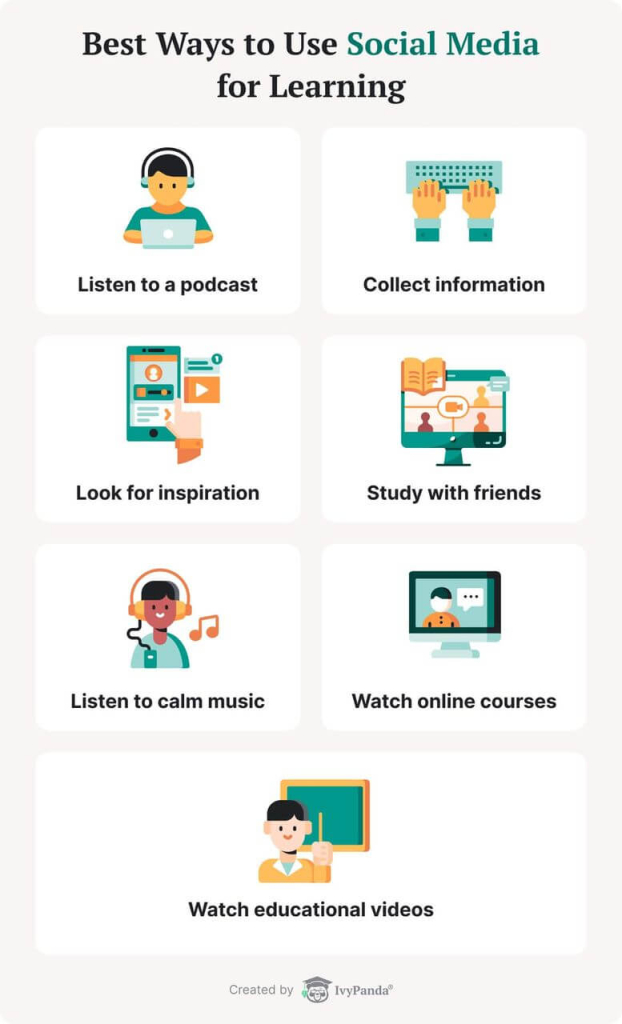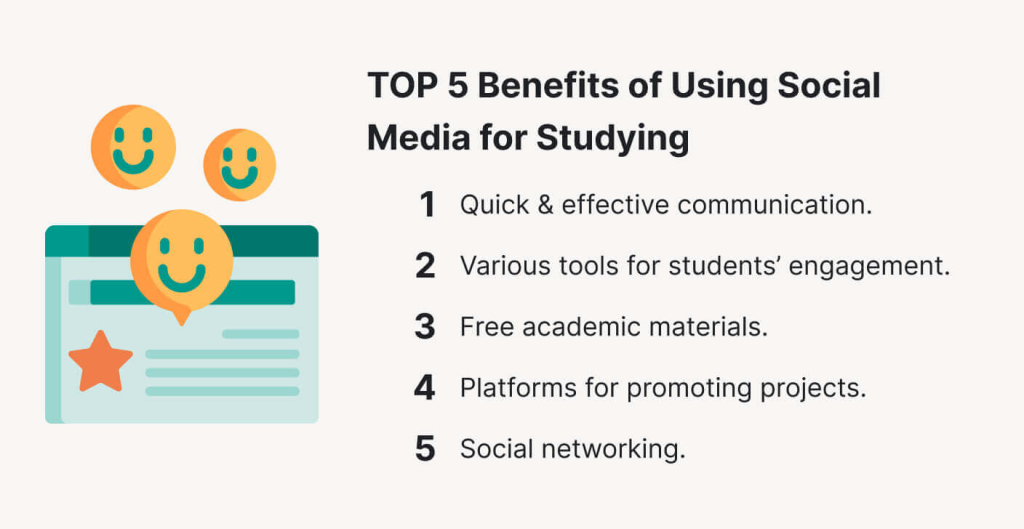Social media learning platforms have revolutionized education by offering students new methods of getting information and enhancing their expertise. When Covid-19 turned the world upside down, technologies became a lifeline for learners, proving that social media can be an effective learning platform. Even now, with students back on campus, learning through social media remains a practical and important way to expand knowledge.
To make the most of these benefits, one should understand how to use social media effectively. For students, this means leveraging online platforms for research, discussions, and networking. In this guide by IvyPanda, you’ll discover:
- Types and examples of social media that can help students in their studies
- Ways to combine social media and learning
- The pros of social media, its cons, and much more
📱 Social Media Types and Examples
When talking about social media platforms, the first thing that comes to mind is Facebook or Instagram. They belong to the social networks category, but many more platforms are available. Social media has developed a lot, and new formats and opportunities have been introduced. In fact, the classification of social media platforms is rapidly changing. Below is the most up-to-date list made by leading experts in the industry.
- Personal blog. A blog is a form of a diary where users can comment and share posts.
Example: The Verge, Lifehacker. - Business network. Business networks are online communities where people with the same profession share information and ideas.
Example: American Medical Association, TeachThought. - Collaborative project. Collaborative projects unite people with the same interests to help them turn their vision into reality.
Example: Slack, Feminist Bird Club. - Enterprise social network. Enterprise social networks are professional communities for employees of a specific company to exchange their experiences.
Example: Salesforce Chatter, Microsoft’s SharePoint. - Forum. A forum is a platform where users can exchange information on different topics.
Example: Reddit, Quora.com. - Microblog. Microblogs include short pieces of content (no more than 200 characters) for quick audience interactions.
Example: Twitter, Tumblr. - Photo sharing. Photo-sharing platforms allow users to upload, edit and organize their photos.
Example: Behance, Pinterest. - Products/services review. Products and services review websites aim to recommend and sell various products.
Example: Google My Business, Amazon, eBay. - Social bookmarking. Social bookmarking sites allow users to collect and share Internet links.
Example: Digg, Slashdot. - Social gaming. Social gaming websites offer online games for players’ interaction.
Example: Kongregate.com, Cartoon Network. - Social network. Social networks connect people’s online profiles so they can communicate, share photos and videos, etc.
Example: Facebook, WhatsApp. - Video sharing. Video-sharing platforms allow users to post, share and comment on private videos or video ads.
Example: YouTube, TikTok. - Virtual world. Virtual worlds unite numerous users who interact with each other in virtual reality with the help of avatars.
Example: Second Life, Kaneva.
🖥️ Social Media and Studying – How to Combine the Two?
Social media platforms can benefit your studying in various ways. In this part, we’ll look at several online tools and how to use them for educational purposes.

- When learning a new topic, listen to a podcast that focuses on your subject. Active sensory listening is an effective tool for memorizing facts, especially if it’s a lively discussion.
- If you have an essay to write, check out video essays on YouTube. This type of content can help you fight writer’s block. You can also use video essays as references for your assignment.
- When you need to collect information for your research, consider Twitter as a source. This platform allows you to analyze various opinions on the most controversial topics.
- If you have an art project to do, our top recommendation is Pinterest. You can find mood boards that follow different aesthetics. Such a great source of inspiration!
- If you enjoy a study room format, consider video chats. Join your friends on Zoom, make sure none of you procrastinates, and do your homework together.
- For better concentration, choose calm music playlists. Some even apply the Pomodoro technique, which reminds you when to take a break.
- When you want to learn something new, choose online courses on platforms like Coursera. Their lectures are made by professionals and are often free to watch
⚖️ Social Media in Education: For & Against
The impact of social media on students’ academic performance is a hot topic for debate. For some people, the advantages of social media in education outweigh all the negative effects. However, not everyone believes that using online platforms benefits students. Let’s see what each side thinks.
Arguments Against Social Media in Education
Argument #1
Using social media for studying can increase cyberbullying. The more time students spend on the Internet, the higher the risk of facing online trolls and cyberbullies.
Argument #2
Social media is addictive and can be demotivating. Even if students browse Facebook for educational purposes, they might be easily distracted by friends’ messages.
Argument #3
Using social media during class can take students away from face-to-face human interaction. Studying is not only about knowledge but also about lively discussions with classmates and professors.
Argument #4
Social media platforms in education belittle the importance of the teacher’s work. Having so many online courses creates the false illusion that students can learn everything independently.
Argument #5
Social media platforms often contain wrong or biased information. Some resources can’t be used for educational purposes if their credibility can’t be checked.
Arguments For Social Media in Education
Argument #1
Social media platforms help students fulfill their creative potential. Not only can they become inspired by other people’s content on Instagram or Pinterest, but they can also create their own.
Argument #2
Students gain access to global knowledge with the help of social media. They can share their academic experience with students from other universities around the world.
Argument #3
Social media is an effective tool for research. For example, Google Scholar gives students access to numerous scientists they can follow in order to be updated about future studies.
Argument #4
Video platforms like Zoom help students with disabilities fully engage in the educational process. For example, the program has a live captions option for people with hearing disabilities.
Argument #5
Social media increases students’ engagement. Since young people devote much time to the Internet, online educational content can be made to seem more attractive and enjoyable.
🪄 Benefits of Using Social Media for Learning
We’ve come up with a list of social media benefits to destroy the myth that social media is a waste of time.

- Social media is an effective and quick communication channel.
- E-learning is only possible with the help of social media platforms.
- Social media gives teachers more tools to get their students’ attention and interest.
- Social media platforms help students demonstrate their creative side.
- The global network makes it possible to learn about other countries and to practice a foreign language.
- Social media makes it easier to collaborate intellectually and socially.
- Social media is full of academic materials that can be used for free.
- Students can learn expert opinions with the help of social networking.
- Students can promote their projects and achievements.
- Students can explore new scientific areas and build their academic paths faster.
- Social media offers new teaching methods that can benefit both students and professors.
- Social media platforms inspire students to study on their own.
- Various news channels on social media can help students to stay up-to-date.
- Reading articles on the Internet helps students to improve their literacy.
- Social media is a never-ending source of inspiration, fulfilling students’ creative potential.
⚡ Risks & Insufficiencies of Using Social Media for Learning
Despite there are many benefits of using social media, it is vital to engage in these platforms carefully. To have the best experience online, consider these risks:
- Social media is created to be addictive, which might cause distraction in the classroom.
- Social media platforms can contain harmful and inappropriate content without proper moderation.
- Spending too much time online can badly influence students’ time-management skills.
- Having easy access to information online can make students less curious or lazy.
- The amount of research papers available on the Internet increases plagiarism rates.
- Using social media in education can expose students to Internet fraud.
- The excessive use of social media for learning can lead to sleeping disorders and depression.
- Social media can reduce students’ attention span.
- Biased articles on social media platforms can badly influence students’ critical thinking.
🧨 Social Media Platforms Teachers & Students Shouldn’t Miss
Online Collaboration Tools
Online collaboration tools allow students and professors to communicate with a simple click. To make your studies in Zoom more productive and entertaining, we recommend checking out these websites.
- Twiddla
Twiddla is a whiteboard for online classes. It allows professors to demonstrate materials and make notes. Twiddla’s fun design also evokes nostalgia for school days. - Kahoot
This game-based learning platform helps teachers make tests and quizzes on their subjects. - StudyStream
StudyStream offers 24/7 virtual focus rooms for students worldwide, enabling them to make new friends and study more productively.
Websites for Research
Research is essential to writing an essay or other assignment. Most of the existing scientific articles can be found with the help of these online tools.
- Google Scholar
Google Scholar gives access to many scientific papers and books. Users can also subscribe to specific authors’ updates and bookmark the works they need. - Bright Knowledge
Bright knowledge is another research database with articles on relatable topics like education, career, and mental health. - Copyleaks
Copyleaks is a top tool for every student to detect plagiarism and paraphrase texts to make them look more academic.
Online Courses and Video Lectures
Online courses are necessary for students who want to deepen their knowledge or try a new scientific field. The following platforms also facilitate communication with experts and other students.
- TedEd
Ted Education is an online platform with hundreds of animated lessons to explain the most complex topics in simple words. - Coursera
Coursera has partnerships with leading universities and companies to create affordable and relevant online learning for students worldwide. - Skillshare
Skillshare is another online learning platform that focuses on the creative fields of design, animation, and fashion.
Tools for Creating Presentations and Visuals.
Visuals can make a student’s work stand out. Luckily, there are plenty of online tools with ready-made presentation templates. You can use them even if you know nothing about design!
- Canva
Canva gives students all the tools to design a presentation, posters, or graphics. - Pixelated
Pixelated offers thousands of ready-made presentation templates for all possible occasions. - Pinterest
Pinterest is a well-known website with photos divided into thematic categories. They can be used both as inspiration and to illustrate your writings.
The never-ending debate about integrating social media into the educational process causes controversies. Our final thought is that online platforms can boost your academic performance if you use them wisely. Pursue new social media tools in education to become the best version of yourself!
References
- 10 Social Media Tools Perfectly Suited for e-Learning
- 12 Ways to Use Social Media for Education | Sprout Social
- Using Social Media for Learning | UAGC | University of Arizona Global Campus
- 6 Pros and Cons of Social Media in the Classroom
- Is Social Media Good or Bad for Students? – Education Corner
- Social Media in the Classroom: The Digital Safety Debate
- Benefits and Drawbacks of Social Media in Education | Wisconsin Center for Education Research
![Social Media Learning Platforms: Are They Underestimated? [2025 Guide]](https://ivypanda.com/blog/wp-content/uploads/2022/05/hands-with-laptop-virtual-world-map-736x491.jpg)
![How to Research: Ultimate Guide [+Online Tools]](https://ivypanda.com/blog/wp-content/uploads/2021/12/multiethnic-team-young-partners-having-meeting-cafeteria-discussing-plans-sharing-ideas-analyzing-financial-data-project-using-laptop-309x208.jpg)

![Studying with Friends: Why You Need a Study Buddy [+Tips]](https://ivypanda.com/blog/wp-content/uploads/2021/07/doing-homework-together-309x208.jpg)